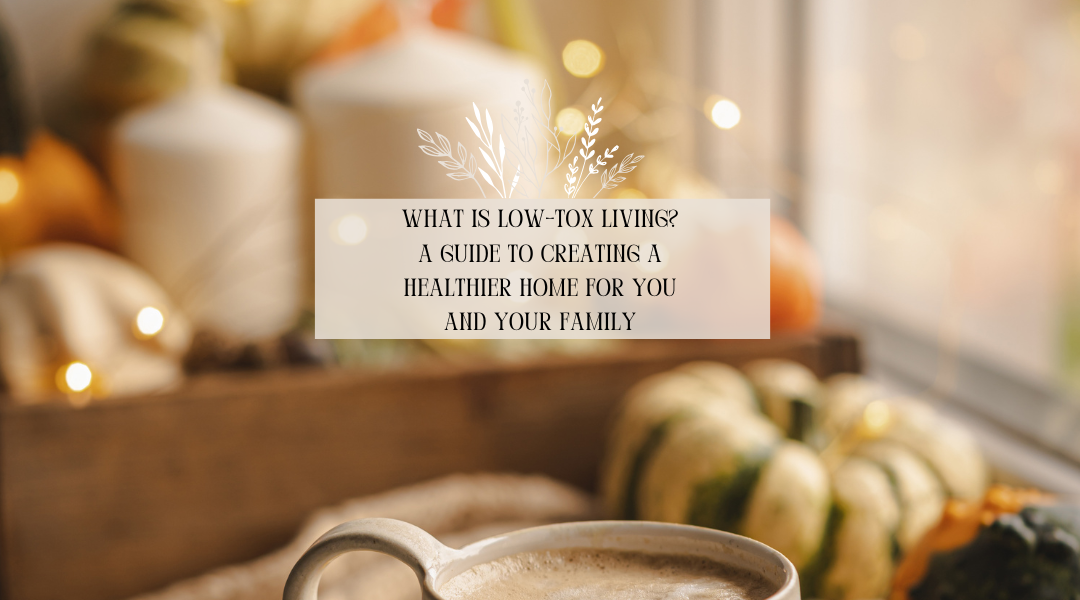In recent years, many women have discovered that the products they use in their homes and on their bodies may be impacting their health in ways they hadn’t realized. If you’re one of the many women who have struggled with health issues, or if you’re simply trying to make better choices to support your family’s well-being, you may have heard of “low-tox living.” But what exactly does it mean? And how can it help improve your health and your family’s health?
This guide will break down the basics of low-tox living, why it matters, and simple steps you can take to start making healthier swaps today.
What is Low-Tox Living?
Low-tox living is a lifestyle focused on reducing or eliminating harmful chemicals and toxins from your home, personal care routines, and diet. The goal is to make choices that minimize your exposure to substances linked to negative health effects. Instead of relying on products with potentially harmful ingredients, low-tox living encourages choosing cleaner, more natural alternatives that can support your body’s natural ability to thrive.
Why Low-Tox Living Matters for Your Health
Many people don’t realize just how many chemicals they come into contact with daily—from the cleaners under the sink to the makeup on their skin. Here’s why low-tox living can be a game-changer for women:
Healthier Hormones: Certain chemicals, such as parabens and phthalates (often found in personal care and cleaning products), are known endocrine disruptors. These can mimic or interfere with natural hormones in the body, leading to imbalances that may affect fertility, mood, and even weight.
Reduced Allergy and Asthma Symptoms: Synthetic fragrances, a common ingredient in household products, can trigger respiratory issues, especially in children or those with asthma. Going low-tox can help reduce exposure to these irritants.
Lowered Risk of Chronic Health Issues: Research suggests that long-term exposure to certain toxins may contribute to the development of chronic conditions such as autoimmune diseases, cancer, and neurological disorders.
Better Overall Wellness: By reducing your exposure to potentially harmful substances, you may find an increase in energy, improved skin health, and a strengthened immune system.
5 Simple Steps to Start Your Low-Tox Journey
If the idea of overhauling every product in your home sounds overwhelming, don’t worry—low-tox living is a journey, not a destination. Here are some actionable steps you can take to get started:
1. Swap Your Cleaning Products
Many traditional cleaning products contain chemicals that can irritate your lungs, skin, and eyes. Start by swapping out one product at a time. Look for brands that prioritize non-toxic, biodegradable ingredients, or make your own cleaners using natural ingredients like vinegar, baking soda, and essential oils.
2. Opt for Non-Toxic Personal Care Items
Our skin absorbs what we put on it, which makes low-tox personal care a crucial area of focus. Opt for natural skincare, makeup, and body care products that avoid synthetic fragrances, parabens, and other harsh chemicals. A quick ingredient check can make a big difference for you and your family.
3. Choose Low-Tox Household Essentials
Common items like laundry detergent, dish soap, and air fresheners can contain hidden chemicals. Choosing low-tox options can improve the air quality in your home. Try switching to fragrance-free or essential-oil-based detergents and avoid aerosol sprays.
4. Focus on Whole Foods and Organic Choices
A low-tox diet emphasizes whole foods, high-quality animal proteins, and nutrient-rich vegetables. Avoiding processed foods and choosing organic when possible helps limit exposure to pesticides, additives, and preservatives. Cooking from scratch also gives you greater control over what goes into your family’s meals.
5. Prioritize Clean Air and Water
The air and water in your home can harbor toxins that aren’t always visible. Using a quality air purifier and filtering your tap water are two small changes that can have a big impact on your low-tox journey. For extra protection, adding a few air-purifying plants around your home can help absorb toxins and release oxygen.
Common Myths About Low-Tox Living
If you’re new to low-tox living, it’s easy to be misled by common myths and misconceptions. Here’s the truth about some of the most common misunderstandings:
Myth #1: Low-tox living is too expensive. The reality is, you don’t need to buy all-new products. Many effective low-tox swaps are budget-friendly, and you can make small changes over time.
Myth #2: Everything natural is safe. Remember, not all “natural” ingredients are automatically safe or effective. It’s important to check labels and do your research.
Myth #3: You need to switch everything at once. Going low-tox doesn’t mean you have to change everything overnight. Start with one area and build from there.
Embracing Low-Tox Living as a Lifestyle
Low-tox living is about more than just reducing chemicals; it’s a holistic approach to wellness. By being mindful of the products you bring into your home and onto your skin, you’re taking proactive steps toward a healthier life for yourself and your loved ones.
Every small swap you make counts, and each one brings you closer to a home that supports your health and well-being. By choosing low-tox living, you’re making an empowering commitment to live better, feel better, and protect your family’s health for the long term.
In Summary: Making Low-Tox Swaps for a Healthier Home
For women who have struggled with health issues, low-tox living can be a gentle but impactful way to support better health. Start small, focus on one area at a time, and enjoy the journey to a cleaner, healthier home. With each swap, you’re creating a safer, more nourishing environment for you and your family to thrive.
Want to learn more about my low-tox journey? Click here to read my story.
Need more in-depth help with low-tox living? Check out my seasonal bundles! These bundles are carefully curated with seasonal wellness guides, recipes, and meal plans to help you thrive in any season.
Want to learn more?
Check out my resources section for free guides and checklists to help you on your low-tox journey!
